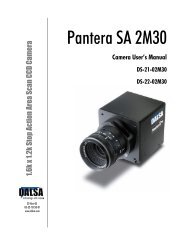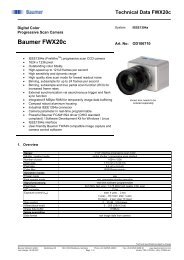Spyder 3 Camera User's Manual GigE Dual Line - Frame Grabbers
Spyder 3 Camera User's Manual GigE Dual Line - Frame Grabbers
Spyder 3 Camera User's Manual GigE Dual Line - Frame Grabbers
Create successful ePaper yourself
Turn your PDF publications into a flip-book with our unique Google optimized e-Paper software.
22<br />
<strong>Spyder</strong> 3 <strong>GigE</strong> User <strong>Manual</strong><br />
Shielded Ethernet Cable Requirements<br />
In order to achieve EMC compliance, the <strong>Spyder</strong> 3 camera requires the use of shielded<br />
CAT5e or CAT6 Ethernet cables.<br />
2.3 Drivers: Overview<br />
High Performance Driver Mode<br />
In high-performance mode, the <strong>Spyder</strong> 3 <strong>GigE</strong> works with the High-Performance IP<br />
Device Driver to transfer data between cameras and PCs with very low, predictable<br />
latency at rates of up to 1 Gb/s (100 MB/s). The video data is streamed directly into PC<br />
memory using almost no PC CPU resources. This leaves the CPU free to process<br />
applications.<br />
To achieve this performance level, PCs must be equipped with a <strong>GigE</strong> network interface<br />
(also referred to as a network adapter) based on Intel’s 82540 chip. Many motherboard<br />
manufacturers are designing this chip directly into their board in “LAN on the<br />
motherboard (LOM)” implementations. Alternately, an Intel 82540-based network<br />
adapter, also known as a network interface card, can be slotted into a PC.<br />
Note: For more information and instructions on installing the drive, refer to the <strong>Spyder</strong> 3<br />
<strong>GigE</strong> Driver <strong>Manual</strong>. To view the manual, point to Programs → DALSA QuickCam →<br />
Documentation → <strong>Spyder</strong> 3 <strong>GigE</strong> Driver <strong>Manual</strong><br />
Note: The DALSA NetLink IP Device Driver supports LOM implementations, but the PCI<br />
identification number for these may be different. Contact DALSA to obtain a driver<br />
installation file compatible with LOMs.<br />
Standard Driver Mode<br />
In standard mode, the <strong>Spyder</strong> 3 <strong>GigE</strong> operates with any vendor’s Ethernet network<br />
adapter. The driver shipped with the adapter transfers the data to the Windows network<br />
stack, which handles IP communications tasks.<br />
Standard mode is recommended for applications where flexibility is more important than<br />
performance. The Windows network stack uses significant levels of CPU processing<br />
power to transfer data to memory, which can result in lost packets, severely degrading<br />
performance.<br />
Standard mode is thus suitable for applications that require bandwidths of only 100 Mb/s<br />
or less. If this mode is used with bandwidths of 1 Gb/s, application performance will<br />
greatly degrade when CPU usage hits 100%. Additionally, at high rates like these,<br />
insufficient CPU resources may be available to process or even display images.<br />
Note: For more information and instructions on installing the drive, refer to the <strong>Spyder</strong> 3<br />
<strong>GigE</strong> Driver <strong>Manual</strong>. To view the manual, point to Programs → DALSA QuickCam →<br />
Documentation → <strong>Spyder</strong> 3 <strong>GigE</strong> Driver <strong>Manual</strong><br />
03-032-10158-06 DALSA
















